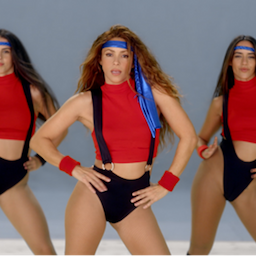ET is looking back at the key moments that have marked Shakira’s global success.
It's been 25 years since Shakira first rose to fame in her native Colombia. Ever since she released Pies Descalzos back in 1995, the Barranquillera artist has climbed to even higher heights, proving to be one of the most influential artists of the 21st century.
Of course, as anyone who witnessed her 2020 Super Bowl performance alongside Jennifer Lopez knows, there’s no sign of Shakira stopping any time soon. To give the groundbreaking Colombian singer her due, we’re looking back at the key moments that have marked her quarter century of hits.
Early Breakthrough
Shakira released her very first album, 1991’s Magia, when she was just 14 years old. The talented singer and songwriter had slowly been building a platform for herself around her native city of Barranquilla. And while Magia promised to be a break for the young black-haired teen, the Sony Colombia record was a commercial failure, as was its follow-up, 1993’s Peligro.
It wouldn’t be until she released “¿Dónde estás corazón?” as part of the Nuestro rock compilation album, that her career would begin taking off in Colombia. That single, which went on to be part of her wildly successful third album, Pies Descalzos, made her a household name -- not just in Colombia, but all over Latin America.
The rock-infused album went platinum in Argentina, Brazil, Chile, Ecuador, Mexico, Peru, Venezuela and even in the U.S., where "Estoy Aqui" became her first single to top Billboard's Latin Pop Songs (aka Latin Pop Airplay) chart, a feat the singer has since accomplished on that chart 18 more times with songs like "Suerte," "Loca" and "Gitana."
Expectations for Shakira’s follow-up album were sky high. But, in a twist of fate that would go on to birth the title of her next album, Shakira’s work on a new batch of songs hit a snag when her luggage, along with her compositions, was stolen in Bogotá. Starting almost from scratch, the self-proclaimed perfectionist delivered ¿Dónde están los Ladrones? (literally, “Where are the thieves?”) in the fall of 1998 to ecstatic reviews.
The album, which includes such hits as “Ciega sordomuda,” “No Creo” and “Inevitable” remains her highest-selling Spanish language effort to date: it has sold over 7 million copies around the world. The MTV Unplugged concert and album that followed two years later further solidified her as one of the most successful female Latin American artists of her generation. With a GRAMMY under her belt (for MTV Unplugged) and a new working relationship with Emilio Estefan, who produced that live album, the Colombian singer set her eyes on that rarest of feats: crossover into the English language market in the U.S.
U.S. Crossover
If Shaki’s early hits suggested she was a soft rocker chick often favorably compared to Alanis Morissette, her first English-language effort incorporated a sound she’d already been toying with in songs like “Ojos Así,” where she’d tapped into her Lebanese roots for that song’s percussion-heavy beat. The musical landscape she offered with 2001’s Laundry Service (released as Servicio de lavandería in 2002) was much more global in scope than the guitar-strung ballads and rock anthems that had first catapulted her to fame.
With a bolder -- and blonder -- look, Shakira introduced herself to the English-language U.S. market with “Whenever Wherever.” Co-written by Shakira with Tim Mitchell and Gloria Estefan (Emilio served as an executive producer for the overall album), the lead single featured what would become signature Shakira flourishes: idiosyncratic lyrics blended with an eclectic, grab-bag of global sounds. Who else, after all, would pair a line like “Lucky that my breasts are small and humble, so you don't confuse them with mountains” with an Andean drum beat?
A worldwide hit, the single made Shakira a superstar in the U.S., part of the so-called “Latin boom” that swept the music industry at the turn of the millennium (see also: Ricky Martin’s “Livin’ la Vida Loca” and J.Lo’s “If You Had My Love”). With over 15 millions copies sold worldwide, Laundry Service remains Shakira's best-selling album. It performed even better in Europe and abroad, setting the stage for the artist’s next goal: to be known all over the entire world.
Global Superstar
Few artists can boast having hits as successful as “Hips Don’t Lie.” The 2006 song, one of the best-selling singles of all time, reached No. 1 in over 55 countries including the U.S. Billboard Hot 100 chart, making it one of the most heard songs of that decade. What makes its success all the more remarkable is that it wasn’t originally recorded for Shakira’s double album Fijación oral vol. 1 and Oral Fixation Vol. 2. The Wyclef Jean collaboration was originally both a Fugees reunion single ("Lips Don't Lie") as well as a song on the Dirty Dancing: Havana Nights soundtrack ("Dance Like This").
Once it became a Shakira song, with samples from Jerry Rivera's "Amores Como el Nuestro" and Grupo Niche's "Ana Mile,” the upbeat single further cemented Shakira as a global superstar whose dance moves would become as iconic as her phrasing and lyrics.
Later hits like “Waka Waka (This Time for Africa)” and “Dare (La La La)” equally increased her global appeal, turning her into the kind of artist who could command crowds for events like the World Cup. That's why it wasn't surprising when she signed a $300 million contract in July 2008 with Live Nation: there was plenty of demand for live performances of the Colombian artist all over the world.
Another way Shakira consolidated herself as an artist who could cross language and cultural barriers (she’s released songs in Spanish, English, Portuguese and French) was by the artists she’s collaborated with over the years.
As much as she stands on her own, Shakira has made a career of uplifting and honoring fellow artists. She’s worked with everyone from Beyoncé, Carlos Vives, Rihanna and Alejandro Sanz to Maná, Freshlyground, Prince Royce, Anuel AA and Maluma in genres as varied as those very names suggest.
Shakira further established herself as a household name with her appearances on TV shows like The Voice and films like Disney's Zootopia, as well as lending her talents to writing songs not only for Zootopia but dramas like Love in the Time of Cholera.
Super Bowl LIV
Despite a health scare that forced the "Empire" singer to postpone her El Dorado tour for a year back in 2017, the last few years have found Shakira both looking back at her music career as well as propelling it forward.
There's no clearer example of this artistic resurgence than her 2020 Super Bowl halftime show alongside Jennifer Lopez.
The much-buzzed-about performance found the Colombian artist revisiting such hits as "She Wolf," "Whenever Wherever," "Chantaje" and "Hips Don't Lie."
With choreography by Liz Dany Campo Diaz that highlighted Colombian dance moves like champeta, the show was a chance for Shakira to honor her roots and her career.
Worldwide Philanthropy
In addition to her artistic output, Shakira has long been a staunch advocate for various charitable efforts. In Colombia, she’s the founder of the Pies Descalzos foundation. Established in 1997, the organization strives to offer education for children affected by the violence in Colombia.
In 2011, she was appointed by President Barack Obama to the President's Advisory Commission on Educational Excellence for Hispanics, committed to using her platform for good.
Quarantine
Like everyone else, the Colombian superstar has had to adjust to the new normal that 2020 has wrought. But that hasn’t stopped her from continuing her philanthropic work. Over the past few months, she’s participated in concerts uplifting health workers, has spoken openly about the crisis at the border, lent her voice to the relief efforts in Beirut following the explosion back in August, urged her U.S. fans to vote in the 2020 election and even partnered with Prince William in the Earthshot Prize, a new environmental initiative.
That she’s also found time to skateboard, surf and even finish a philosophy course is a testament to her indefatigable spirit, proving why she remains an unstoppable force in the music industry 25 years after she first broke out.
RELATED CONTENT:




